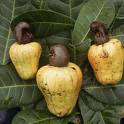It is a small evergreen tree growing to 10-12m (~32 ft) tall, with a short, often irregularly shaped trunk. The leaves are spirally arranged, leathery textured, elliptic to obovate, 4 to 22 cm long and 2 to 15 cm broad, with a smooth margin. The flowers are produced in a panicle or corymb up to 26 cm long, each flower small, pale green at first then turning reddish, with five slender, acute petals 7 to 15 mm long.
What appears to be the fruit of the cashew tree is an oval or pear-shaped accessory fruit (sometimes called a pseudo carp or false fruit) that develops from the receptacle of the cashew flower. Called the cashew apple, it ripens into a yellow and/or red structure about 5–11 cm long. It is edible, and has a strong "sweet" smell and a sweet taste. The pulp of the cashew apple is very juicy, but the skin is fragile, making it unsuitable for transport.

 The true fruit of the cashew tree is a kidney or boxing-glove shaped drupe that grows at the end of the accessory fruit. The drupe develops first on the tree, and then the peduncle expands into the cashew apple. Within the true fruit is a single seed, the cashew nut. Although a nut in the culinary sense, in the botanical sense the nut of the cashew is a seed. The seed is surrounded by a double shell containing an allergenic phenolic resin, anacardic acid, a potent skin irritant chemically related to the more well known allergenic oil urushiol which is also a toxin found in the related poison ivoy. Some people are allergic to cashew nuts, but cashews are a less frequent allergen than nuts or peanuts.
The true fruit of the cashew tree is a kidney or boxing-glove shaped drupe that grows at the end of the accessory fruit. The drupe develops first on the tree, and then the peduncle expands into the cashew apple. Within the true fruit is a single seed, the cashew nut. Although a nut in the culinary sense, in the botanical sense the nut of the cashew is a seed. The seed is surrounded by a double shell containing an allergenic phenolic resin, anacardic acid, a potent skin irritant chemically related to the more well known allergenic oil urushiol which is also a toxin found in the related poison ivoy. Some people are allergic to cashew nuts, but cashews are a less frequent allergen than nuts or peanuts.In Goa, India, the cashew apple (the accessory fruit) is mashed, the juice is extracted and kept for fermentation for 2–3 days. Fermented juice then undergoes a double distillation process. The resulting beverage is called fenny.
![]()
If you like this please Link Back to this article...















0 comments:
Post a Comment
Note: Only a member of this blog may post a comment.